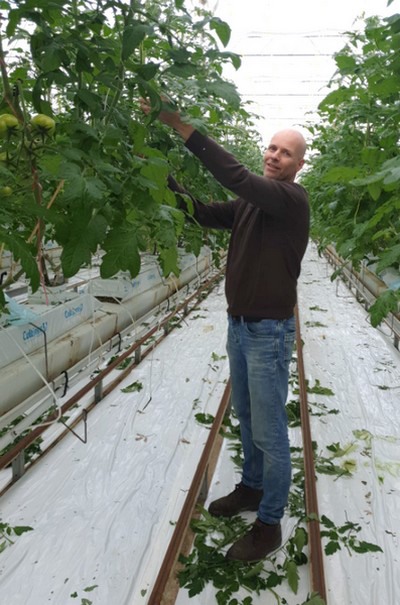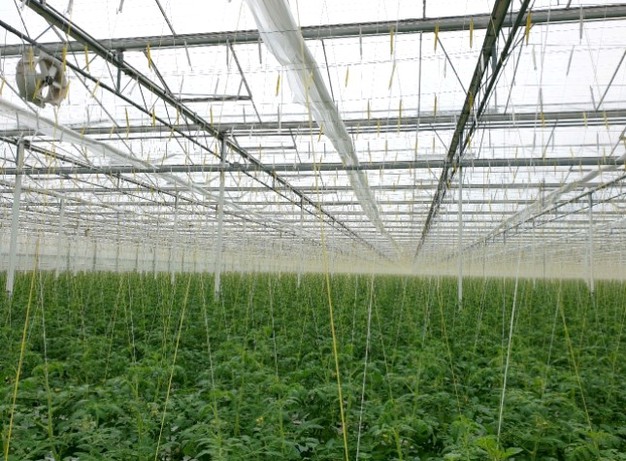 Tomato juice flows through his veins and whether it's at 4 in the morning or 10 in the evening, Marc Groenewegen from Prominent Grevelingen never gets tired of talking about plant load, 24-hour temperatures, or stretching. He now does this not only with colleagues from the growers' association but also with growers worldwide. They talk endlessly about cultivation.
Tomato juice flows through his veins and whether it's at 4 in the morning or 10 in the evening, Marc Groenewegen from Prominent Grevelingen never gets tired of talking about plant load, 24-hour temperatures, or stretching. He now does this not only with colleagues from the growers' association but also with growers worldwide. They talk endlessly about cultivation.
Young plants
They are neatly lined up in Prominent Grevelingen's greenhouses once more. The young tomato plants went into the greenhouse on 10 January and they are already starting to grow. Not surprising: the plants they order from the plant grower already have quite a lot of body. "We are located on Sirjansland between two nature reserves and are not allowed to use additional lighting here. So the plants are allowed to stay under the lights at the nursery for quite a long time. We receive them with a strong cluster, well colored, with a strong first shoot and lots of energy", summarises Mark. "That means we have flowering less than ten days later. This is quite different from growers who bring home a much smaller and cheaper plant at the beginning of December."
The plant breeder already knows at sowing that the plants will have to produce until Christmas. "And still have to look beautiful by then. It's a shame to pull them out every year," Marc says. The decision to continue until Christmas was made a long time ago. "Most growers want to be with their wives at Christmas. We say 'come and cut tomatoes because the prices are good.' Thanks to our strategy, we still have a beautiful crop that produces in abundance. Seven kg m2 is the target for top quality in December. In that respect, it's a top-class sport: just like Ireen Wüst, the Dutch speed skater, we have to peak at the right moment."

Peaking at the right time
Peaking at the right time is what the entire cultivation process in the 11-hectare nursery is designed to achieve. Born and bred among tomatoes, Marc has gathered a lot of knowledge about the plants. "Of course, it's about the ratio of light and temperature, but you have to start at the beginning: the plant's vitality and health." He compares it to a well-trained marathon runner versus a runner who is severely obese. "The first still gets further on a hot dog than the other on a couple of litres of energy drink. You have to feel good before you can deliver a top performance."
For Nursery Prominent-Grevelingen, that doesn't mean achieving as much growth as possible per day; they are going for the long term and that includes stress, because that's how you build up resilience in the crop. That is why the 24-hour period is divided into periods of 4 hours - 6 per 24-hour period. "Within these periods, I try to do the right thing for the plant. That means that we give the plant stress at certain times of the day and let it grow at other times. If you would just reverse that, you would get stretching, weakness and bad pollen." In doing so, Marc goes a little against the growing popularity of Plant Empowerment, for example, in which the plant is mainly steered towards the largest and fastest possible growth. "That is fine for lettuce heads, but in fruiting vegetables, the focus should also be on creating strong pollen. And certainly, if you are going for a long cultivation period and this requires stress."
Again, a nice comparison. "If you grow with a lot of moisture and temperature, you go to the climate around the equator. There, banana trees grow very fast. But they have huge leaves and very few roots. The fruits are the favorite food of monkeys. I prefer to look at the cacti in North Africa, where it is very dry and the crop experiences an enormous amount of stress. Because of this, the cactus produces bright red flowers and fruits. The fruits contain Aloe Vera, which Cleopatra smeared on her face! The roots reach 50 meters into the ground. Such a plant can take a beating and last for years. We look at it and learn from it. You can make a plant grow fast for a short while, but you will irrevocably lose power and energy. What matters is to have a crop in the greenhouse that is as balanced as possible throughout the entire cultivation period, with the right ratio of sink to source. This also requires stress."
Contacts all over the world
Marc has not only gained his knowledge from his own cultivation. Through LinkedIn, he has come into contact with growers all over the world, from Kazakhstan to Australia. Then a message pops up. We see something on that plant and we don't know what it is, do you want to take a look? And being the tomato crazed guy that he is, he is happy to do so. "Then you also see what happens in other climates. In Kazakhstan, there is a meter of snow outside. We had that last year in week 6 as well, so you can see what happens there and we take advantage of it. Or in Australia - where it's sizzling hot and very dry. Or when someone grows 40 hectares under LED lighting. We may have years of experience in growing tomatoes, but they know a lot more about LED lighting than we do here in the Netherlands. They learn from me and I learn from them. Like, for example, that translating everything to the Dutch situation really doesn't make sense - something he still sees happening regularly internationally. "You have to respect the local conditions. In the Netherlands, we have extra CO2 from Shell Pernis, and we can dose 250 kg per ha per hour. They don't have that over there. If you copy the Dutch cultivation system, things will go wrong."
The knowledge he brings back from abroad is also the challenge of the future. "In Australia and New Zealand, there are some empty greenhouses, because there is nobody to do the work, due to the mandatory European vaccinations and the strict requirements for work visas. In Europe, this is still different, but we will soon face labor challenges here as well. We are now trying to retain people and experimenting with new things, such as the leaf-cutting robot Kompano. We see the potential and the need for this."
Woodfuel
At the same time, there are also things that Marc cannot explain. Not to international growers and not to people in the Netherlands either. Four years ago, together with two neighbors, the company invested in a wood combustion plant. Extremely sustainable, everyone said at the time. "It may seem advantageous now not to use gas, but the truth is different. The subsidy we receive on the uneconomic part of the operation is linked to the gas price, but not to the spark spread. So the higher the gas price, the lower the subsidy. So now we are at a disadvantage with this sustainable boiler compared to the CHP. It takes you from the market to very high energy costs.
"We grow traditionally and, as an additional advantage, fortunately, do not have to deal much with expensive electricity. We haven't run much risk with our energy contracts and we let the CHP run alongside them. This is going well. But it is very frustrating: everyone, including ourselves, was very proud when we started using the system and we thought we were doing something good for the environment, and when nothing changes, the wood boiler costs more than the CHP. That's incomprehensible to a normal person."
For more information:
Marc Groenewegen (LinkedIn)
Prominent Grevelingen
www.prominent-tomatoes.nl
